Go Green and How IT can Help?
VerifiedAdded on 2023/06/05
|12
|3140
|367
AI Summary
This report discusses the Go Green concept and its impact on the environment and society. It outlines methods of maintaining the Go Green model, two perspectives of the concept, and the role of green computing in enhancing it.
Contribute Materials
Your contribution can guide someone’s learning journey. Share your
documents today.
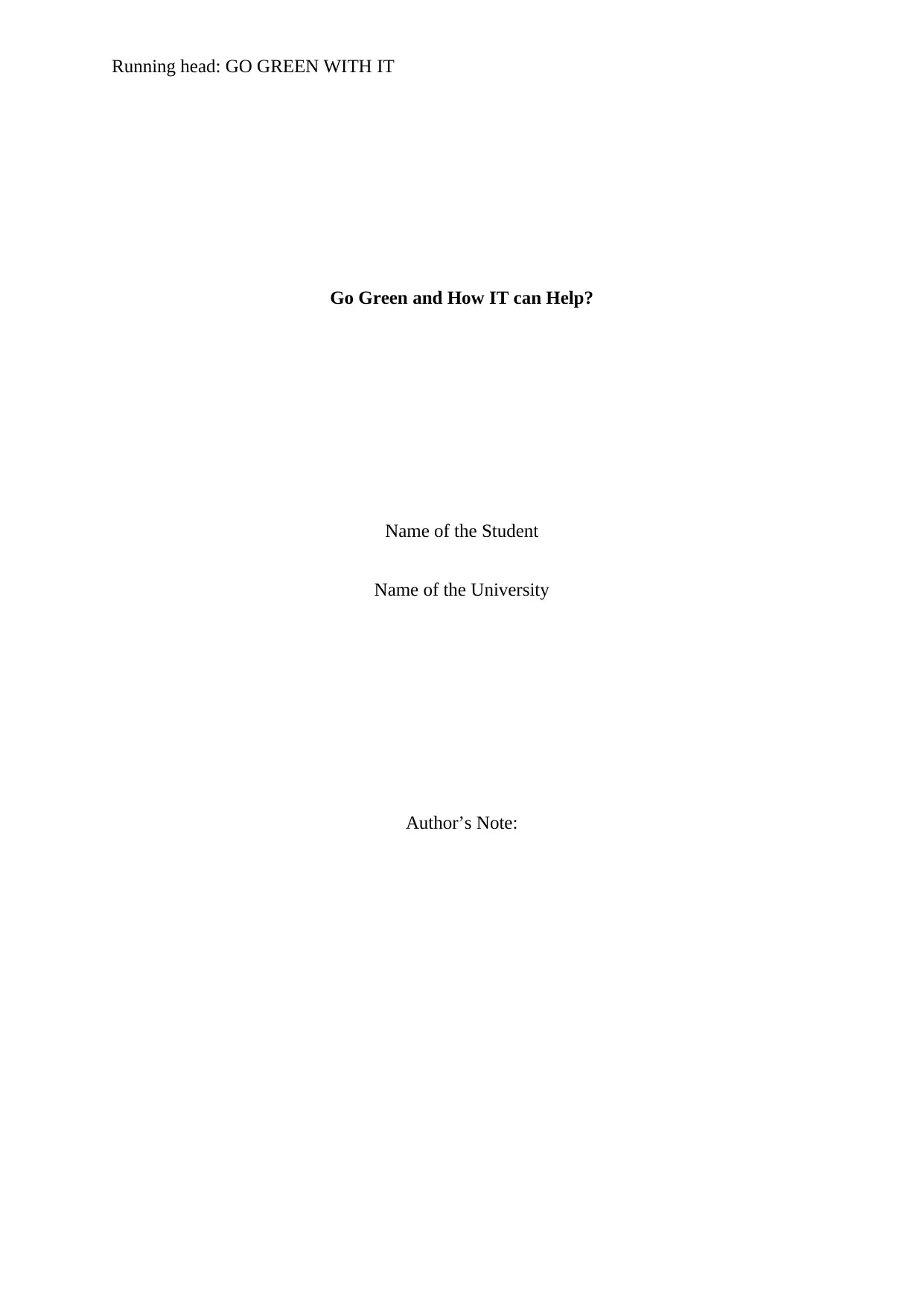
Running head: GO GREEN WITH IT
Go Green and How IT can Help?
Name of the Student
Name of the University
Author’s Note:
Go Green and How IT can Help?
Name of the Student
Name of the University
Author’s Note:
Secure Best Marks with AI Grader
Need help grading? Try our AI Grader for instant feedback on your assignments.
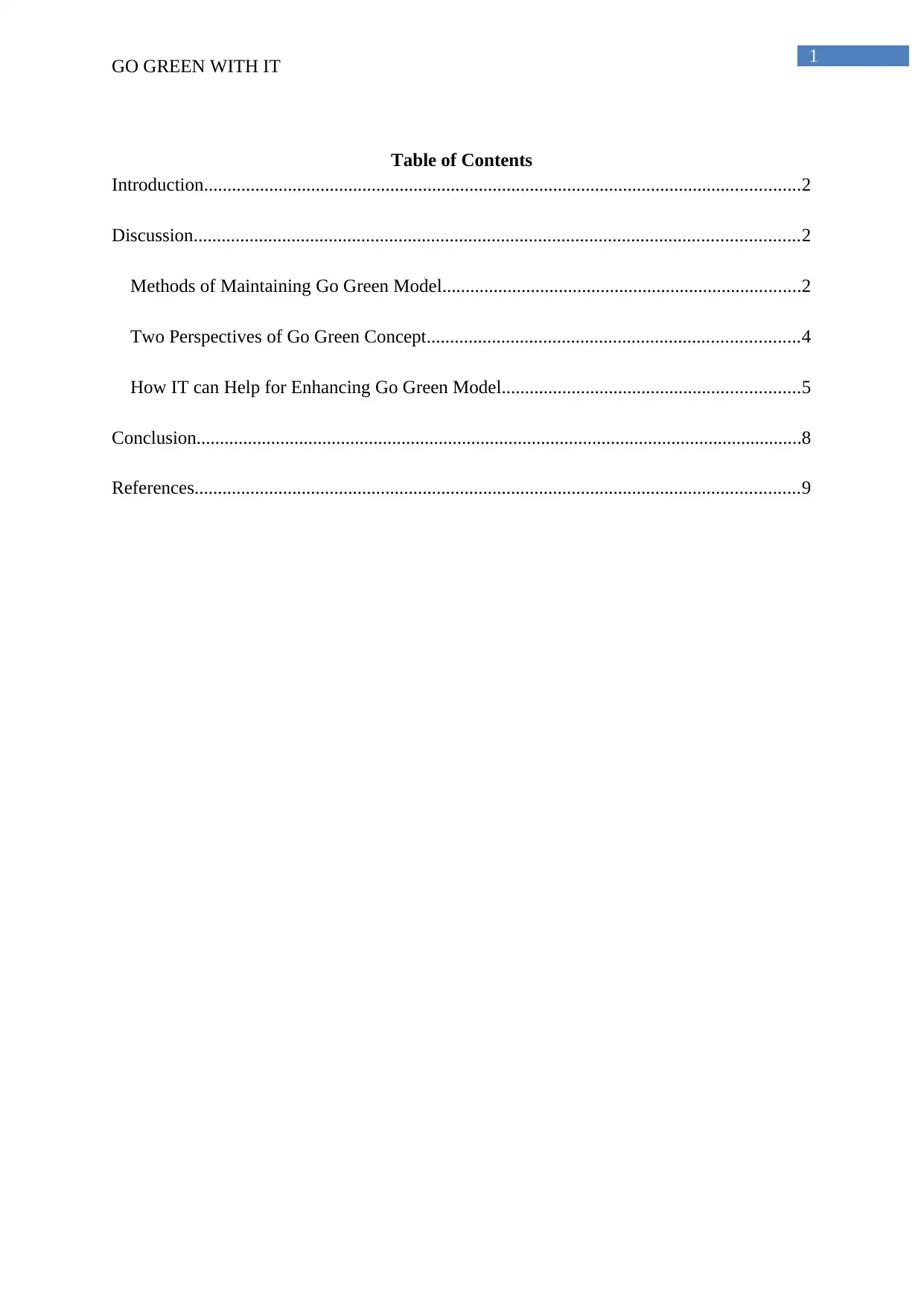
1
GO GREEN WITH IT
Table of Contents
Introduction................................................................................................................................2
Discussion..................................................................................................................................2
Methods of Maintaining Go Green Model.............................................................................2
Two Perspectives of Go Green Concept................................................................................4
How IT can Help for Enhancing Go Green Model................................................................5
Conclusion..................................................................................................................................8
References..................................................................................................................................9
GO GREEN WITH IT
Table of Contents
Introduction................................................................................................................................2
Discussion..................................................................................................................................2
Methods of Maintaining Go Green Model.............................................................................2
Two Perspectives of Go Green Concept................................................................................4
How IT can Help for Enhancing Go Green Model................................................................5
Conclusion..................................................................................................................................8
References..................................................................................................................................9
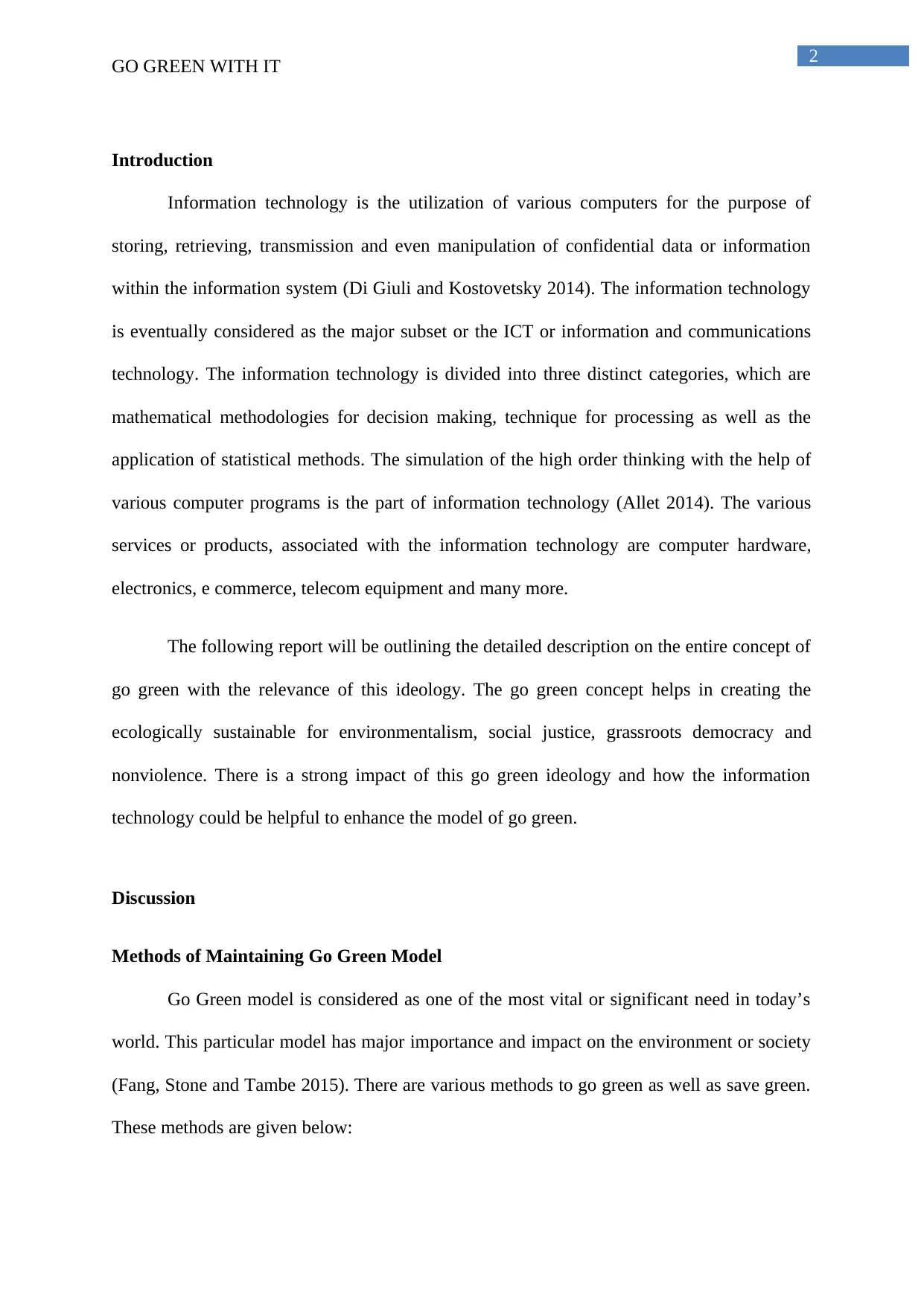
2
GO GREEN WITH IT
Introduction
Information technology is the utilization of various computers for the purpose of
storing, retrieving, transmission and even manipulation of confidential data or information
within the information system (Di Giuli and Kostovetsky 2014). The information technology
is eventually considered as the major subset or the ICT or information and communications
technology. The information technology is divided into three distinct categories, which are
mathematical methodologies for decision making, technique for processing as well as the
application of statistical methods. The simulation of the high order thinking with the help of
various computer programs is the part of information technology (Allet 2014). The various
services or products, associated with the information technology are computer hardware,
electronics, e commerce, telecom equipment and many more.
The following report will be outlining the detailed description on the entire concept of
go green with the relevance of this ideology. The go green concept helps in creating the
ecologically sustainable for environmentalism, social justice, grassroots democracy and
nonviolence. There is a strong impact of this go green ideology and how the information
technology could be helpful to enhance the model of go green.
Discussion
Methods of Maintaining Go Green Model
Go Green model is considered as one of the most vital or significant need in today’s
world. This particular model has major importance and impact on the environment or society
(Fang, Stone and Tambe 2015). There are various methods to go green as well as save green.
These methods are given below:
GO GREEN WITH IT
Introduction
Information technology is the utilization of various computers for the purpose of
storing, retrieving, transmission and even manipulation of confidential data or information
within the information system (Di Giuli and Kostovetsky 2014). The information technology
is eventually considered as the major subset or the ICT or information and communications
technology. The information technology is divided into three distinct categories, which are
mathematical methodologies for decision making, technique for processing as well as the
application of statistical methods. The simulation of the high order thinking with the help of
various computer programs is the part of information technology (Allet 2014). The various
services or products, associated with the information technology are computer hardware,
electronics, e commerce, telecom equipment and many more.
The following report will be outlining the detailed description on the entire concept of
go green with the relevance of this ideology. The go green concept helps in creating the
ecologically sustainable for environmentalism, social justice, grassroots democracy and
nonviolence. There is a strong impact of this go green ideology and how the information
technology could be helpful to enhance the model of go green.
Discussion
Methods of Maintaining Go Green Model
Go Green model is considered as one of the most vital or significant need in today’s
world. This particular model has major importance and impact on the environment or society
(Fang, Stone and Tambe 2015). There are various methods to go green as well as save green.
These methods are given below:
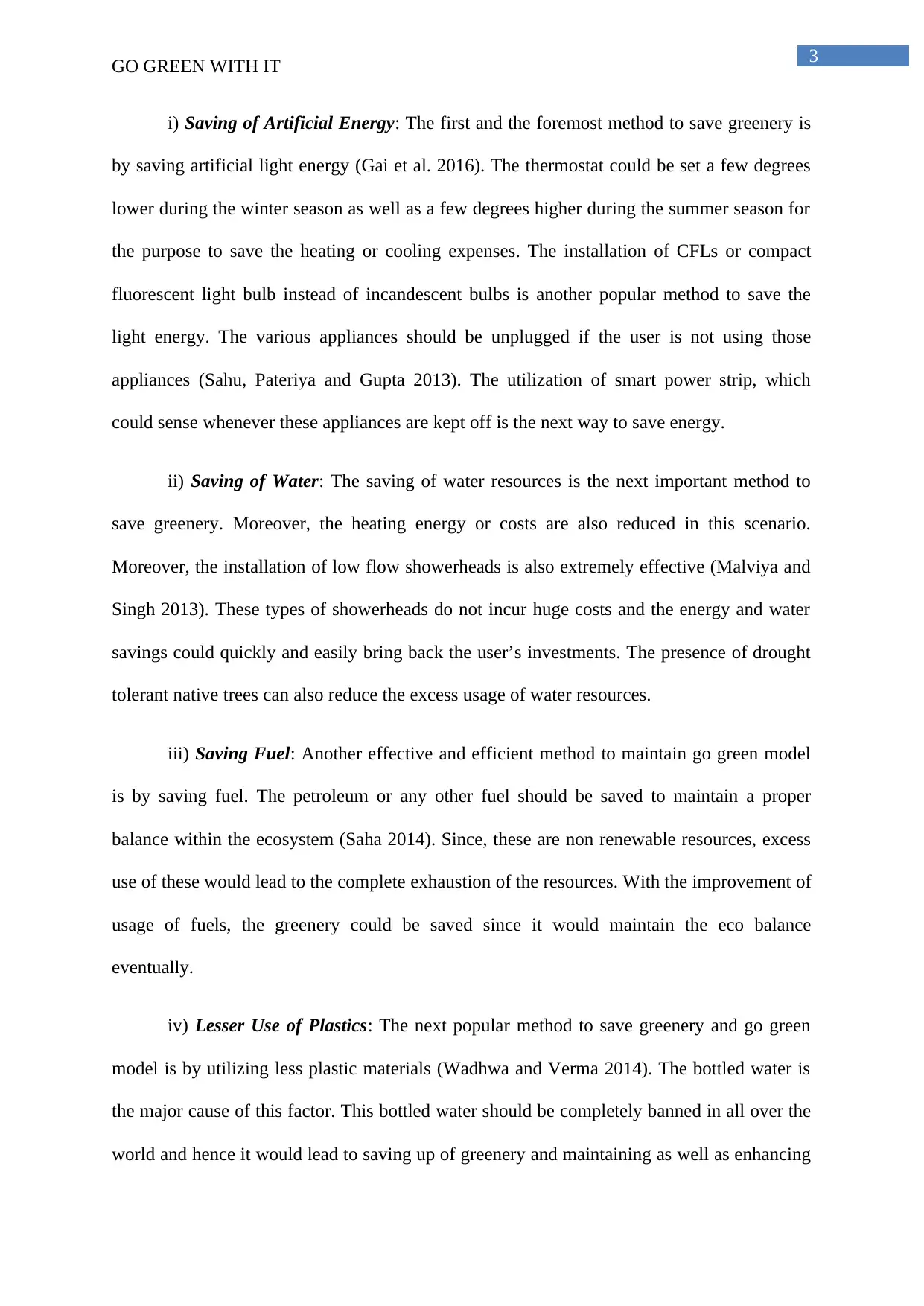
3
GO GREEN WITH IT
i) Saving of Artificial Energy: The first and the foremost method to save greenery is
by saving artificial light energy (Gai et al. 2016). The thermostat could be set a few degrees
lower during the winter season as well as a few degrees higher during the summer season for
the purpose to save the heating or cooling expenses. The installation of CFLs or compact
fluorescent light bulb instead of incandescent bulbs is another popular method to save the
light energy. The various appliances should be unplugged if the user is not using those
appliances (Sahu, Pateriya and Gupta 2013). The utilization of smart power strip, which
could sense whenever these appliances are kept off is the next way to save energy.
ii) Saving of Water: The saving of water resources is the next important method to
save greenery. Moreover, the heating energy or costs are also reduced in this scenario.
Moreover, the installation of low flow showerheads is also extremely effective (Malviya and
Singh 2013). These types of showerheads do not incur huge costs and the energy and water
savings could quickly and easily bring back the user’s investments. The presence of drought
tolerant native trees can also reduce the excess usage of water resources.
iii) Saving Fuel: Another effective and efficient method to maintain go green model
is by saving fuel. The petroleum or any other fuel should be saved to maintain a proper
balance within the ecosystem (Saha 2014). Since, these are non renewable resources, excess
use of these would lead to the complete exhaustion of the resources. With the improvement of
usage of fuels, the greenery could be saved since it would maintain the eco balance
eventually.
iv) Lesser Use of Plastics: The next popular method to save greenery and go green
model is by utilizing less plastic materials (Wadhwa and Verma 2014). The bottled water is
the major cause of this factor. This bottled water should be completely banned in all over the
world and hence it would lead to saving up of greenery and maintaining as well as enhancing
GO GREEN WITH IT
i) Saving of Artificial Energy: The first and the foremost method to save greenery is
by saving artificial light energy (Gai et al. 2016). The thermostat could be set a few degrees
lower during the winter season as well as a few degrees higher during the summer season for
the purpose to save the heating or cooling expenses. The installation of CFLs or compact
fluorescent light bulb instead of incandescent bulbs is another popular method to save the
light energy. The various appliances should be unplugged if the user is not using those
appliances (Sahu, Pateriya and Gupta 2013). The utilization of smart power strip, which
could sense whenever these appliances are kept off is the next way to save energy.
ii) Saving of Water: The saving of water resources is the next important method to
save greenery. Moreover, the heating energy or costs are also reduced in this scenario.
Moreover, the installation of low flow showerheads is also extremely effective (Malviya and
Singh 2013). These types of showerheads do not incur huge costs and the energy and water
savings could quickly and easily bring back the user’s investments. The presence of drought
tolerant native trees can also reduce the excess usage of water resources.
iii) Saving Fuel: Another effective and efficient method to maintain go green model
is by saving fuel. The petroleum or any other fuel should be saved to maintain a proper
balance within the ecosystem (Saha 2014). Since, these are non renewable resources, excess
use of these would lead to the complete exhaustion of the resources. With the improvement of
usage of fuels, the greenery could be saved since it would maintain the eco balance
eventually.
iv) Lesser Use of Plastics: The next popular method to save greenery and go green
model is by utilizing less plastic materials (Wadhwa and Verma 2014). The bottled water is
the major cause of this factor. This bottled water should be completely banned in all over the
world and hence it would lead to saving up of greenery and maintaining as well as enhancing
Secure Best Marks with AI Grader
Need help grading? Try our AI Grader for instant feedback on your assignments.
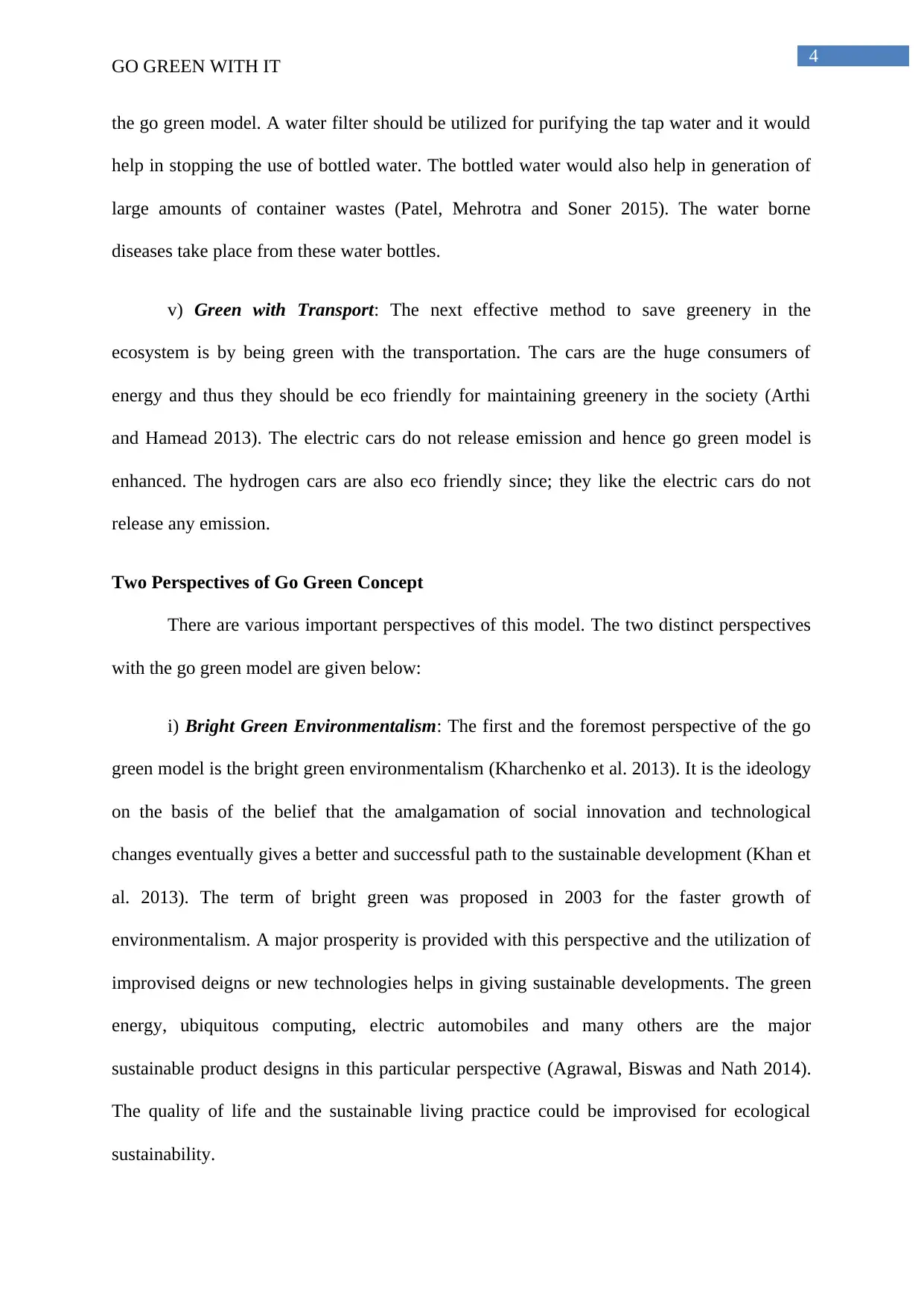
4
GO GREEN WITH IT
the go green model. A water filter should be utilized for purifying the tap water and it would
help in stopping the use of bottled water. The bottled water would also help in generation of
large amounts of container wastes (Patel, Mehrotra and Soner 2015). The water borne
diseases take place from these water bottles.
v) Green with Transport: The next effective method to save greenery in the
ecosystem is by being green with the transportation. The cars are the huge consumers of
energy and thus they should be eco friendly for maintaining greenery in the society (Arthi
and Hamead 2013). The electric cars do not release emission and hence go green model is
enhanced. The hydrogen cars are also eco friendly since; they like the electric cars do not
release any emission.
Two Perspectives of Go Green Concept
There are various important perspectives of this model. The two distinct perspectives
with the go green model are given below:
i) Bright Green Environmentalism: The first and the foremost perspective of the go
green model is the bright green environmentalism (Kharchenko et al. 2013). It is the ideology
on the basis of the belief that the amalgamation of social innovation and technological
changes eventually gives a better and successful path to the sustainable development (Khan et
al. 2013). The term of bright green was proposed in 2003 for the faster growth of
environmentalism. A major prosperity is provided with this perspective and the utilization of
improvised deigns or new technologies helps in giving sustainable developments. The green
energy, ubiquitous computing, electric automobiles and many others are the major
sustainable product designs in this particular perspective (Agrawal, Biswas and Nath 2014).
The quality of life and the sustainable living practice could be improvised for ecological
sustainability.
GO GREEN WITH IT
the go green model. A water filter should be utilized for purifying the tap water and it would
help in stopping the use of bottled water. The bottled water would also help in generation of
large amounts of container wastes (Patel, Mehrotra and Soner 2015). The water borne
diseases take place from these water bottles.
v) Green with Transport: The next effective method to save greenery in the
ecosystem is by being green with the transportation. The cars are the huge consumers of
energy and thus they should be eco friendly for maintaining greenery in the society (Arthi
and Hamead 2013). The electric cars do not release emission and hence go green model is
enhanced. The hydrogen cars are also eco friendly since; they like the electric cars do not
release any emission.
Two Perspectives of Go Green Concept
There are various important perspectives of this model. The two distinct perspectives
with the go green model are given below:
i) Bright Green Environmentalism: The first and the foremost perspective of the go
green model is the bright green environmentalism (Kharchenko et al. 2013). It is the ideology
on the basis of the belief that the amalgamation of social innovation and technological
changes eventually gives a better and successful path to the sustainable development (Khan et
al. 2013). The term of bright green was proposed in 2003 for the faster growth of
environmentalism. A major prosperity is provided with this perspective and the utilization of
improvised deigns or new technologies helps in giving sustainable developments. The green
energy, ubiquitous computing, electric automobiles and many others are the major
sustainable product designs in this particular perspective (Agrawal, Biswas and Nath 2014).
The quality of life and the sustainable living practice could be improvised for ecological
sustainability.
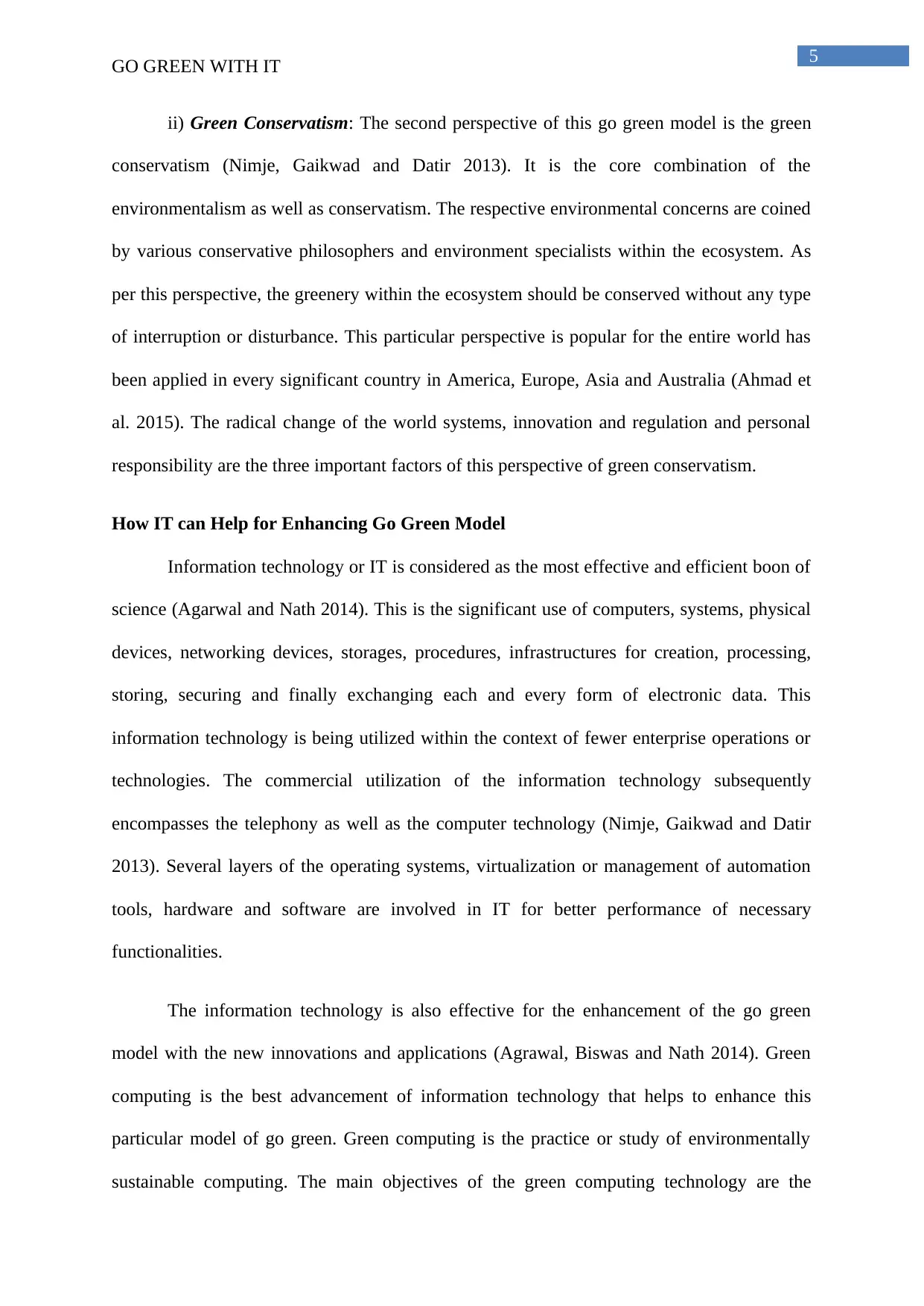
5
GO GREEN WITH IT
ii) Green Conservatism: The second perspective of this go green model is the green
conservatism (Nimje, Gaikwad and Datir 2013). It is the core combination of the
environmentalism as well as conservatism. The respective environmental concerns are coined
by various conservative philosophers and environment specialists within the ecosystem. As
per this perspective, the greenery within the ecosystem should be conserved without any type
of interruption or disturbance. This particular perspective is popular for the entire world has
been applied in every significant country in America, Europe, Asia and Australia (Ahmad et
al. 2015). The radical change of the world systems, innovation and regulation and personal
responsibility are the three important factors of this perspective of green conservatism.
How IT can Help for Enhancing Go Green Model
Information technology or IT is considered as the most effective and efficient boon of
science (Agarwal and Nath 2014). This is the significant use of computers, systems, physical
devices, networking devices, storages, procedures, infrastructures for creation, processing,
storing, securing and finally exchanging each and every form of electronic data. This
information technology is being utilized within the context of fewer enterprise operations or
technologies. The commercial utilization of the information technology subsequently
encompasses the telephony as well as the computer technology (Nimje, Gaikwad and Datir
2013). Several layers of the operating systems, virtualization or management of automation
tools, hardware and software are involved in IT for better performance of necessary
functionalities.
The information technology is also effective for the enhancement of the go green
model with the new innovations and applications (Agrawal, Biswas and Nath 2014). Green
computing is the best advancement of information technology that helps to enhance this
particular model of go green. Green computing is the practice or study of environmentally
sustainable computing. The main objectives of the green computing technology are the
GO GREEN WITH IT
ii) Green Conservatism: The second perspective of this go green model is the green
conservatism (Nimje, Gaikwad and Datir 2013). It is the core combination of the
environmentalism as well as conservatism. The respective environmental concerns are coined
by various conservative philosophers and environment specialists within the ecosystem. As
per this perspective, the greenery within the ecosystem should be conserved without any type
of interruption or disturbance. This particular perspective is popular for the entire world has
been applied in every significant country in America, Europe, Asia and Australia (Ahmad et
al. 2015). The radical change of the world systems, innovation and regulation and personal
responsibility are the three important factors of this perspective of green conservatism.
How IT can Help for Enhancing Go Green Model
Information technology or IT is considered as the most effective and efficient boon of
science (Agarwal and Nath 2014). This is the significant use of computers, systems, physical
devices, networking devices, storages, procedures, infrastructures for creation, processing,
storing, securing and finally exchanging each and every form of electronic data. This
information technology is being utilized within the context of fewer enterprise operations or
technologies. The commercial utilization of the information technology subsequently
encompasses the telephony as well as the computer technology (Nimje, Gaikwad and Datir
2013). Several layers of the operating systems, virtualization or management of automation
tools, hardware and software are involved in IT for better performance of necessary
functionalities.
The information technology is also effective for the enhancement of the go green
model with the new innovations and applications (Agrawal, Biswas and Nath 2014). Green
computing is the best advancement of information technology that helps to enhance this
particular model of go green. Green computing is the practice or study of environmentally
sustainable computing. The main objectives of the green computing technology are the
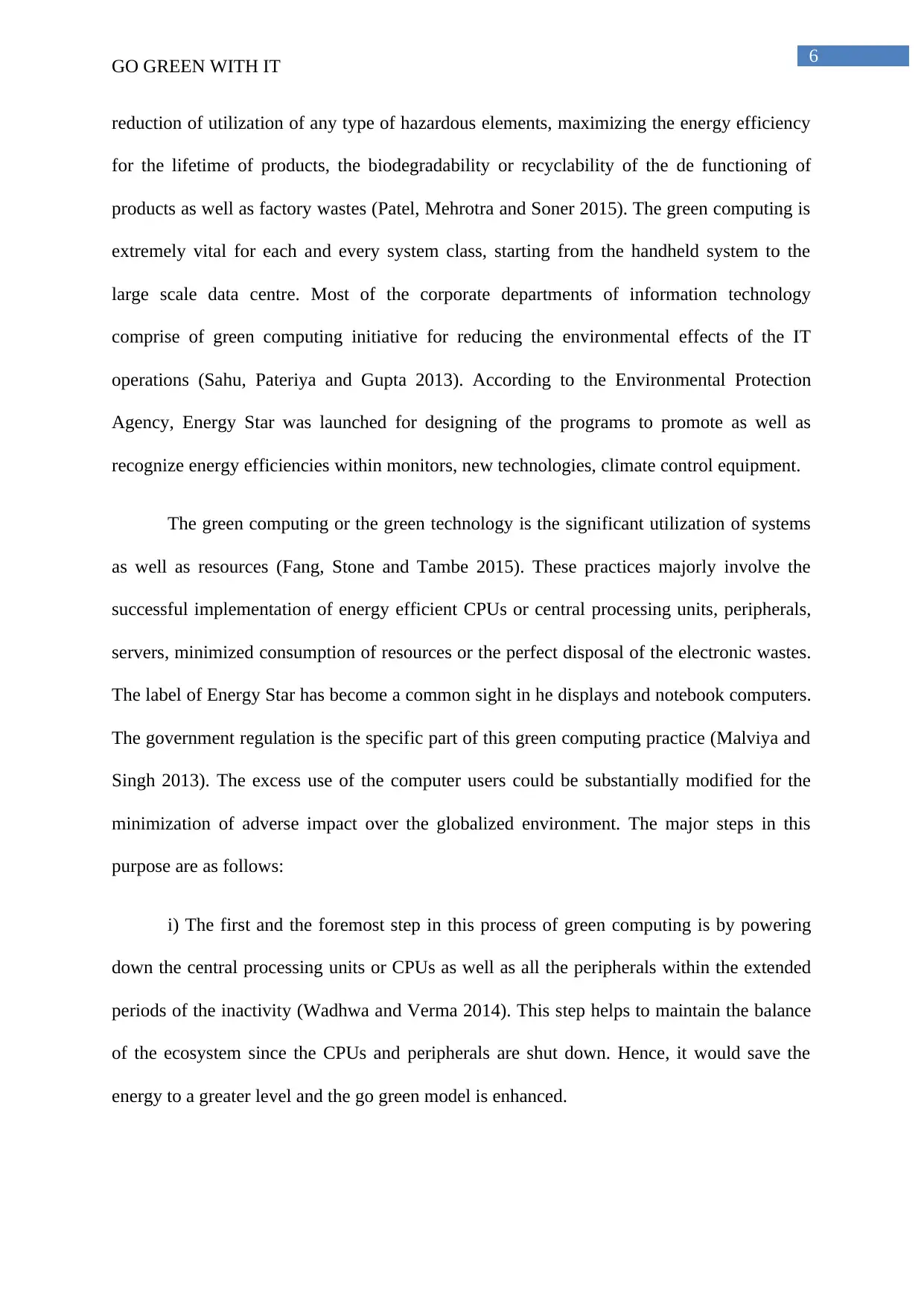
6
GO GREEN WITH IT
reduction of utilization of any type of hazardous elements, maximizing the energy efficiency
for the lifetime of products, the biodegradability or recyclability of the de functioning of
products as well as factory wastes (Patel, Mehrotra and Soner 2015). The green computing is
extremely vital for each and every system class, starting from the handheld system to the
large scale data centre. Most of the corporate departments of information technology
comprise of green computing initiative for reducing the environmental effects of the IT
operations (Sahu, Pateriya and Gupta 2013). According to the Environmental Protection
Agency, Energy Star was launched for designing of the programs to promote as well as
recognize energy efficiencies within monitors, new technologies, climate control equipment.
The green computing or the green technology is the significant utilization of systems
as well as resources (Fang, Stone and Tambe 2015). These practices majorly involve the
successful implementation of energy efficient CPUs or central processing units, peripherals,
servers, minimized consumption of resources or the perfect disposal of the electronic wastes.
The label of Energy Star has become a common sight in he displays and notebook computers.
The government regulation is the specific part of this green computing practice (Malviya and
Singh 2013). The excess use of the computer users could be substantially modified for the
minimization of adverse impact over the globalized environment. The major steps in this
purpose are as follows:
i) The first and the foremost step in this process of green computing is by powering
down the central processing units or CPUs as well as all the peripherals within the extended
periods of the inactivity (Wadhwa and Verma 2014). This step helps to maintain the balance
of the ecosystem since the CPUs and peripherals are shut down. Hence, it would save the
energy to a greater level and the go green model is enhanced.
GO GREEN WITH IT
reduction of utilization of any type of hazardous elements, maximizing the energy efficiency
for the lifetime of products, the biodegradability or recyclability of the de functioning of
products as well as factory wastes (Patel, Mehrotra and Soner 2015). The green computing is
extremely vital for each and every system class, starting from the handheld system to the
large scale data centre. Most of the corporate departments of information technology
comprise of green computing initiative for reducing the environmental effects of the IT
operations (Sahu, Pateriya and Gupta 2013). According to the Environmental Protection
Agency, Energy Star was launched for designing of the programs to promote as well as
recognize energy efficiencies within monitors, new technologies, climate control equipment.
The green computing or the green technology is the significant utilization of systems
as well as resources (Fang, Stone and Tambe 2015). These practices majorly involve the
successful implementation of energy efficient CPUs or central processing units, peripherals,
servers, minimized consumption of resources or the perfect disposal of the electronic wastes.
The label of Energy Star has become a common sight in he displays and notebook computers.
The government regulation is the specific part of this green computing practice (Malviya and
Singh 2013). The excess use of the computer users could be substantially modified for the
minimization of adverse impact over the globalized environment. The major steps in this
purpose are as follows:
i) The first and the foremost step in this process of green computing is by powering
down the central processing units or CPUs as well as all the peripherals within the extended
periods of the inactivity (Wadhwa and Verma 2014). This step helps to maintain the balance
of the ecosystem since the CPUs and peripherals are shut down. Hence, it would save the
energy to a greater level and the go green model is enhanced.
Paraphrase This Document
Need a fresh take? Get an instant paraphrase of this document with our AI Paraphraser
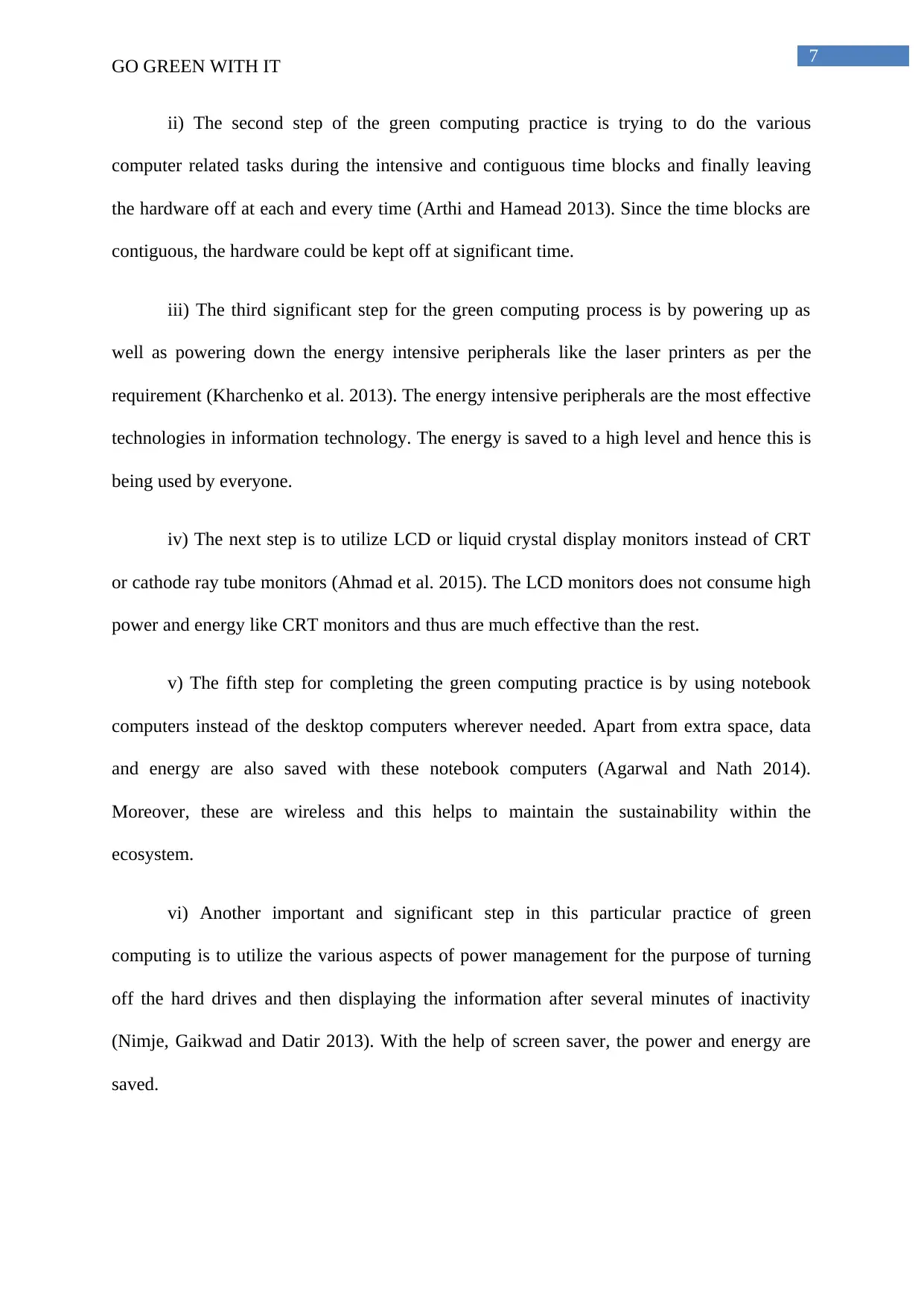
7
GO GREEN WITH IT
ii) The second step of the green computing practice is trying to do the various
computer related tasks during the intensive and contiguous time blocks and finally leaving
the hardware off at each and every time (Arthi and Hamead 2013). Since the time blocks are
contiguous, the hardware could be kept off at significant time.
iii) The third significant step for the green computing process is by powering up as
well as powering down the energy intensive peripherals like the laser printers as per the
requirement (Kharchenko et al. 2013). The energy intensive peripherals are the most effective
technologies in information technology. The energy is saved to a high level and hence this is
being used by everyone.
iv) The next step is to utilize LCD or liquid crystal display monitors instead of CRT
or cathode ray tube monitors (Ahmad et al. 2015). The LCD monitors does not consume high
power and energy like CRT monitors and thus are much effective than the rest.
v) The fifth step for completing the green computing practice is by using notebook
computers instead of the desktop computers wherever needed. Apart from extra space, data
and energy are also saved with these notebook computers (Agarwal and Nath 2014).
Moreover, these are wireless and this helps to maintain the sustainability within the
ecosystem.
vi) Another important and significant step in this particular practice of green
computing is to utilize the various aspects of power management for the purpose of turning
off the hard drives and then displaying the information after several minutes of inactivity
(Nimje, Gaikwad and Datir 2013). With the help of screen saver, the power and energy are
saved.
GO GREEN WITH IT
ii) The second step of the green computing practice is trying to do the various
computer related tasks during the intensive and contiguous time blocks and finally leaving
the hardware off at each and every time (Arthi and Hamead 2013). Since the time blocks are
contiguous, the hardware could be kept off at significant time.
iii) The third significant step for the green computing process is by powering up as
well as powering down the energy intensive peripherals like the laser printers as per the
requirement (Kharchenko et al. 2013). The energy intensive peripherals are the most effective
technologies in information technology. The energy is saved to a high level and hence this is
being used by everyone.
iv) The next step is to utilize LCD or liquid crystal display monitors instead of CRT
or cathode ray tube monitors (Ahmad et al. 2015). The LCD monitors does not consume high
power and energy like CRT monitors and thus are much effective than the rest.
v) The fifth step for completing the green computing practice is by using notebook
computers instead of the desktop computers wherever needed. Apart from extra space, data
and energy are also saved with these notebook computers (Agarwal and Nath 2014).
Moreover, these are wireless and this helps to maintain the sustainability within the
ecosystem.
vi) Another important and significant step in this particular practice of green
computing is to utilize the various aspects of power management for the purpose of turning
off the hard drives and then displaying the information after several minutes of inactivity
(Nimje, Gaikwad and Datir 2013). With the help of screen saver, the power and energy are
saved.
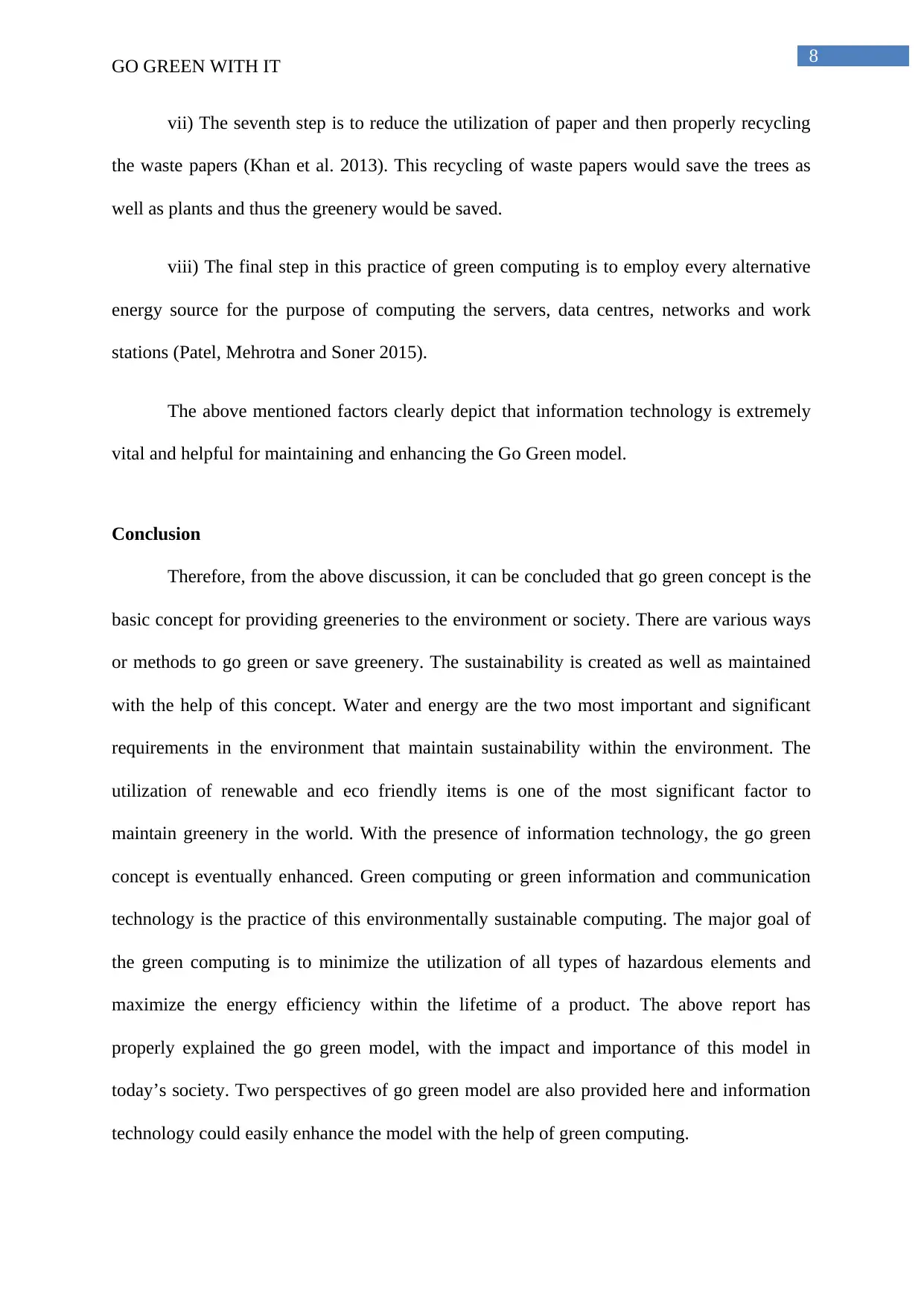
8
GO GREEN WITH IT
vii) The seventh step is to reduce the utilization of paper and then properly recycling
the waste papers (Khan et al. 2013). This recycling of waste papers would save the trees as
well as plants and thus the greenery would be saved.
viii) The final step in this practice of green computing is to employ every alternative
energy source for the purpose of computing the servers, data centres, networks and work
stations (Patel, Mehrotra and Soner 2015).
The above mentioned factors clearly depict that information technology is extremely
vital and helpful for maintaining and enhancing the Go Green model.
Conclusion
Therefore, from the above discussion, it can be concluded that go green concept is the
basic concept for providing greeneries to the environment or society. There are various ways
or methods to go green or save greenery. The sustainability is created as well as maintained
with the help of this concept. Water and energy are the two most important and significant
requirements in the environment that maintain sustainability within the environment. The
utilization of renewable and eco friendly items is one of the most significant factor to
maintain greenery in the world. With the presence of information technology, the go green
concept is eventually enhanced. Green computing or green information and communication
technology is the practice of this environmentally sustainable computing. The major goal of
the green computing is to minimize the utilization of all types of hazardous elements and
maximize the energy efficiency within the lifetime of a product. The above report has
properly explained the go green model, with the impact and importance of this model in
today’s society. Two perspectives of go green model are also provided here and information
technology could easily enhance the model with the help of green computing.
GO GREEN WITH IT
vii) The seventh step is to reduce the utilization of paper and then properly recycling
the waste papers (Khan et al. 2013). This recycling of waste papers would save the trees as
well as plants and thus the greenery would be saved.
viii) The final step in this practice of green computing is to employ every alternative
energy source for the purpose of computing the servers, data centres, networks and work
stations (Patel, Mehrotra and Soner 2015).
The above mentioned factors clearly depict that information technology is extremely
vital and helpful for maintaining and enhancing the Go Green model.
Conclusion
Therefore, from the above discussion, it can be concluded that go green concept is the
basic concept for providing greeneries to the environment or society. There are various ways
or methods to go green or save greenery. The sustainability is created as well as maintained
with the help of this concept. Water and energy are the two most important and significant
requirements in the environment that maintain sustainability within the environment. The
utilization of renewable and eco friendly items is one of the most significant factor to
maintain greenery in the world. With the presence of information technology, the go green
concept is eventually enhanced. Green computing or green information and communication
technology is the practice of this environmentally sustainable computing. The major goal of
the green computing is to minimize the utilization of all types of hazardous elements and
maximize the energy efficiency within the lifetime of a product. The above report has
properly explained the go green model, with the impact and importance of this model in
today’s society. Two perspectives of go green model are also provided here and information
technology could easily enhance the model with the help of green computing.
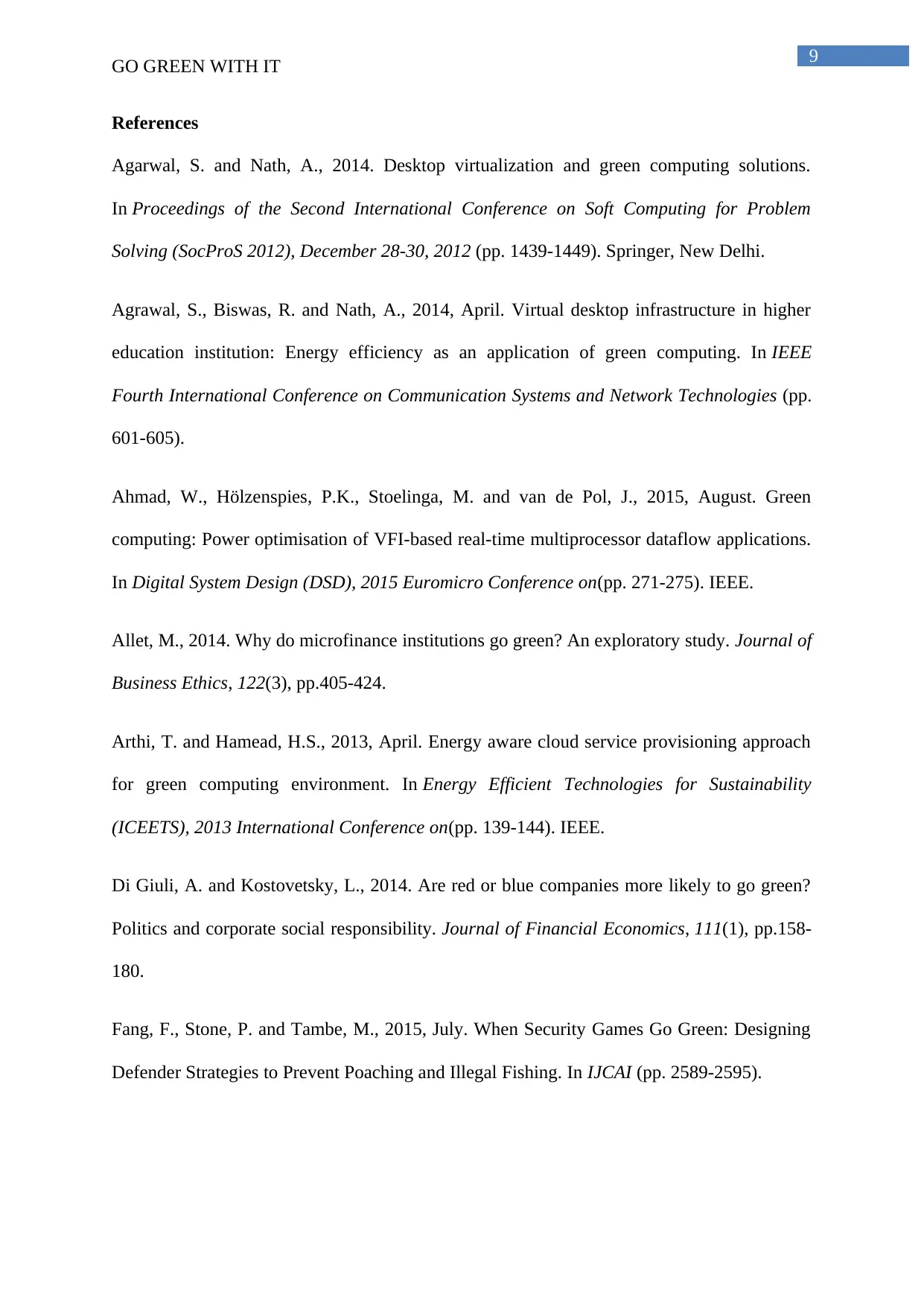
9
GO GREEN WITH IT
References
Agarwal, S. and Nath, A., 2014. Desktop virtualization and green computing solutions.
In Proceedings of the Second International Conference on Soft Computing for Problem
Solving (SocProS 2012), December 28-30, 2012 (pp. 1439-1449). Springer, New Delhi.
Agrawal, S., Biswas, R. and Nath, A., 2014, April. Virtual desktop infrastructure in higher
education institution: Energy efficiency as an application of green computing. In IEEE
Fourth International Conference on Communication Systems and Network Technologies (pp.
601-605).
Ahmad, W., Hölzenspies, P.K., Stoelinga, M. and van de Pol, J., 2015, August. Green
computing: Power optimisation of VFI-based real-time multiprocessor dataflow applications.
In Digital System Design (DSD), 2015 Euromicro Conference on(pp. 271-275). IEEE.
Allet, M., 2014. Why do microfinance institutions go green? An exploratory study. Journal of
Business Ethics, 122(3), pp.405-424.
Arthi, T. and Hamead, H.S., 2013, April. Energy aware cloud service provisioning approach
for green computing environment. In Energy Efficient Technologies for Sustainability
(ICEETS), 2013 International Conference on(pp. 139-144). IEEE.
Di Giuli, A. and Kostovetsky, L., 2014. Are red or blue companies more likely to go green?
Politics and corporate social responsibility. Journal of Financial Economics, 111(1), pp.158-
180.
Fang, F., Stone, P. and Tambe, M., 2015, July. When Security Games Go Green: Designing
Defender Strategies to Prevent Poaching and Illegal Fishing. In IJCAI (pp. 2589-2595).
GO GREEN WITH IT
References
Agarwal, S. and Nath, A., 2014. Desktop virtualization and green computing solutions.
In Proceedings of the Second International Conference on Soft Computing for Problem
Solving (SocProS 2012), December 28-30, 2012 (pp. 1439-1449). Springer, New Delhi.
Agrawal, S., Biswas, R. and Nath, A., 2014, April. Virtual desktop infrastructure in higher
education institution: Energy efficiency as an application of green computing. In IEEE
Fourth International Conference on Communication Systems and Network Technologies (pp.
601-605).
Ahmad, W., Hölzenspies, P.K., Stoelinga, M. and van de Pol, J., 2015, August. Green
computing: Power optimisation of VFI-based real-time multiprocessor dataflow applications.
In Digital System Design (DSD), 2015 Euromicro Conference on(pp. 271-275). IEEE.
Allet, M., 2014. Why do microfinance institutions go green? An exploratory study. Journal of
Business Ethics, 122(3), pp.405-424.
Arthi, T. and Hamead, H.S., 2013, April. Energy aware cloud service provisioning approach
for green computing environment. In Energy Efficient Technologies for Sustainability
(ICEETS), 2013 International Conference on(pp. 139-144). IEEE.
Di Giuli, A. and Kostovetsky, L., 2014. Are red or blue companies more likely to go green?
Politics and corporate social responsibility. Journal of Financial Economics, 111(1), pp.158-
180.
Fang, F., Stone, P. and Tambe, M., 2015, July. When Security Games Go Green: Designing
Defender Strategies to Prevent Poaching and Illegal Fishing. In IJCAI (pp. 2589-2595).
Secure Best Marks with AI Grader
Need help grading? Try our AI Grader for instant feedback on your assignments.
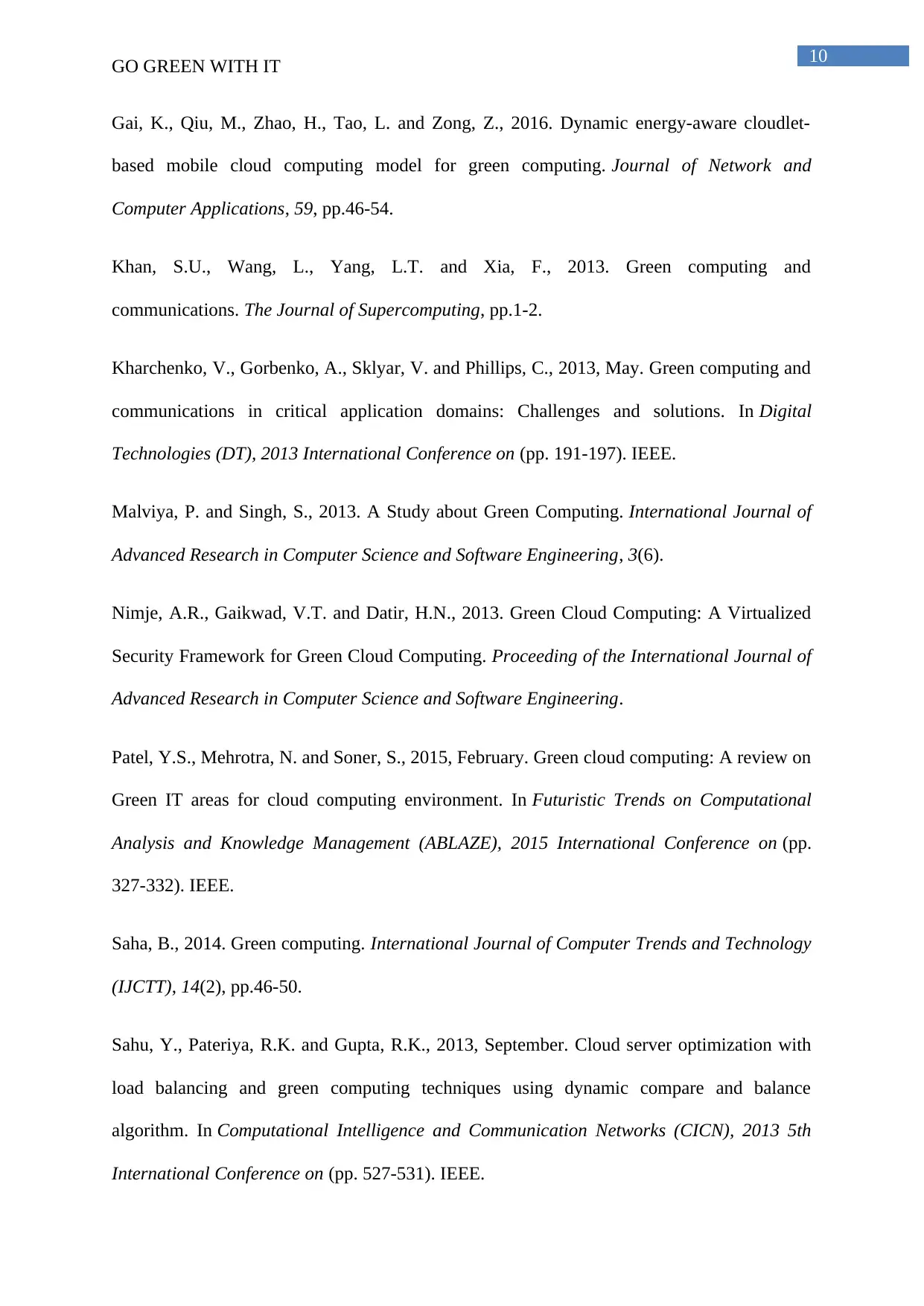
10
GO GREEN WITH IT
Gai, K., Qiu, M., Zhao, H., Tao, L. and Zong, Z., 2016. Dynamic energy-aware cloudlet-
based mobile cloud computing model for green computing. Journal of Network and
Computer Applications, 59, pp.46-54.
Khan, S.U., Wang, L., Yang, L.T. and Xia, F., 2013. Green computing and
communications. The Journal of Supercomputing, pp.1-2.
Kharchenko, V., Gorbenko, A., Sklyar, V. and Phillips, C., 2013, May. Green computing and
communications in critical application domains: Challenges and solutions. In Digital
Technologies (DT), 2013 International Conference on (pp. 191-197). IEEE.
Malviya, P. and Singh, S., 2013. A Study about Green Computing. International Journal of
Advanced Research in Computer Science and Software Engineering, 3(6).
Nimje, A.R., Gaikwad, V.T. and Datir, H.N., 2013. Green Cloud Computing: A Virtualized
Security Framework for Green Cloud Computing. Proceeding of the International Journal of
Advanced Research in Computer Science and Software Engineering.
Patel, Y.S., Mehrotra, N. and Soner, S., 2015, February. Green cloud computing: A review on
Green IT areas for cloud computing environment. In Futuristic Trends on Computational
Analysis and Knowledge Management (ABLAZE), 2015 International Conference on (pp.
327-332). IEEE.
Saha, B., 2014. Green computing. International Journal of Computer Trends and Technology
(IJCTT), 14(2), pp.46-50.
Sahu, Y., Pateriya, R.K. and Gupta, R.K., 2013, September. Cloud server optimization with
load balancing and green computing techniques using dynamic compare and balance
algorithm. In Computational Intelligence and Communication Networks (CICN), 2013 5th
International Conference on (pp. 527-531). IEEE.
GO GREEN WITH IT
Gai, K., Qiu, M., Zhao, H., Tao, L. and Zong, Z., 2016. Dynamic energy-aware cloudlet-
based mobile cloud computing model for green computing. Journal of Network and
Computer Applications, 59, pp.46-54.
Khan, S.U., Wang, L., Yang, L.T. and Xia, F., 2013. Green computing and
communications. The Journal of Supercomputing, pp.1-2.
Kharchenko, V., Gorbenko, A., Sklyar, V. and Phillips, C., 2013, May. Green computing and
communications in critical application domains: Challenges and solutions. In Digital
Technologies (DT), 2013 International Conference on (pp. 191-197). IEEE.
Malviya, P. and Singh, S., 2013. A Study about Green Computing. International Journal of
Advanced Research in Computer Science and Software Engineering, 3(6).
Nimje, A.R., Gaikwad, V.T. and Datir, H.N., 2013. Green Cloud Computing: A Virtualized
Security Framework for Green Cloud Computing. Proceeding of the International Journal of
Advanced Research in Computer Science and Software Engineering.
Patel, Y.S., Mehrotra, N. and Soner, S., 2015, February. Green cloud computing: A review on
Green IT areas for cloud computing environment. In Futuristic Trends on Computational
Analysis and Knowledge Management (ABLAZE), 2015 International Conference on (pp.
327-332). IEEE.
Saha, B., 2014. Green computing. International Journal of Computer Trends and Technology
(IJCTT), 14(2), pp.46-50.
Sahu, Y., Pateriya, R.K. and Gupta, R.K., 2013, September. Cloud server optimization with
load balancing and green computing techniques using dynamic compare and balance
algorithm. In Computational Intelligence and Communication Networks (CICN), 2013 5th
International Conference on (pp. 527-531). IEEE.

11
GO GREEN WITH IT
Wadhwa, B. and Verma, A., 2014, March. Energy saving approaches for Green Cloud
Computing: A review. In Engineering and Computational Sciences (RAECS), 2014 Recent
Advances in (pp. 1-6). IEEE.
GO GREEN WITH IT
Wadhwa, B. and Verma, A., 2014, March. Energy saving approaches for Green Cloud
Computing: A review. In Engineering and Computational Sciences (RAECS), 2014 Recent
Advances in (pp. 1-6). IEEE.
1 out of 12
Related Documents
Your All-in-One AI-Powered Toolkit for Academic Success.
+13062052269
info@desklib.com
Available 24*7 on WhatsApp / Email
![[object Object]](/_next/static/media/star-bottom.7253800d.svg)
Unlock your academic potential
© 2024 | Zucol Services PVT LTD | All rights reserved.





